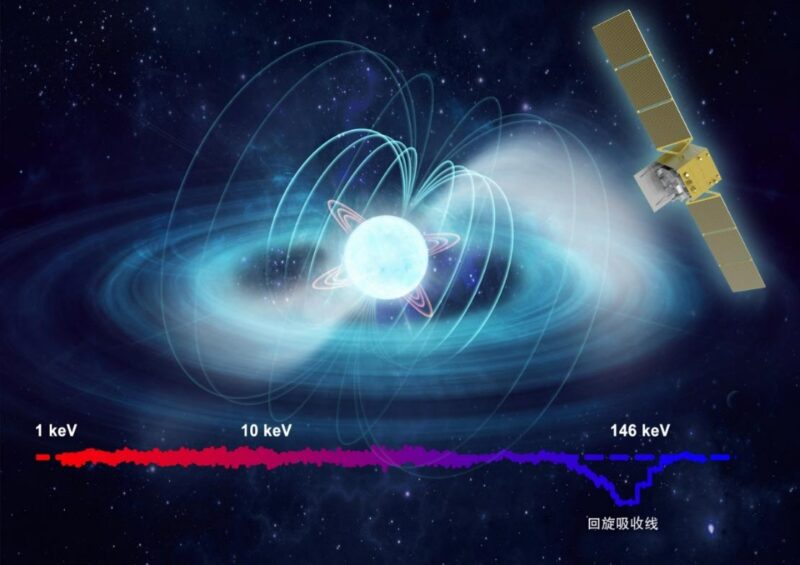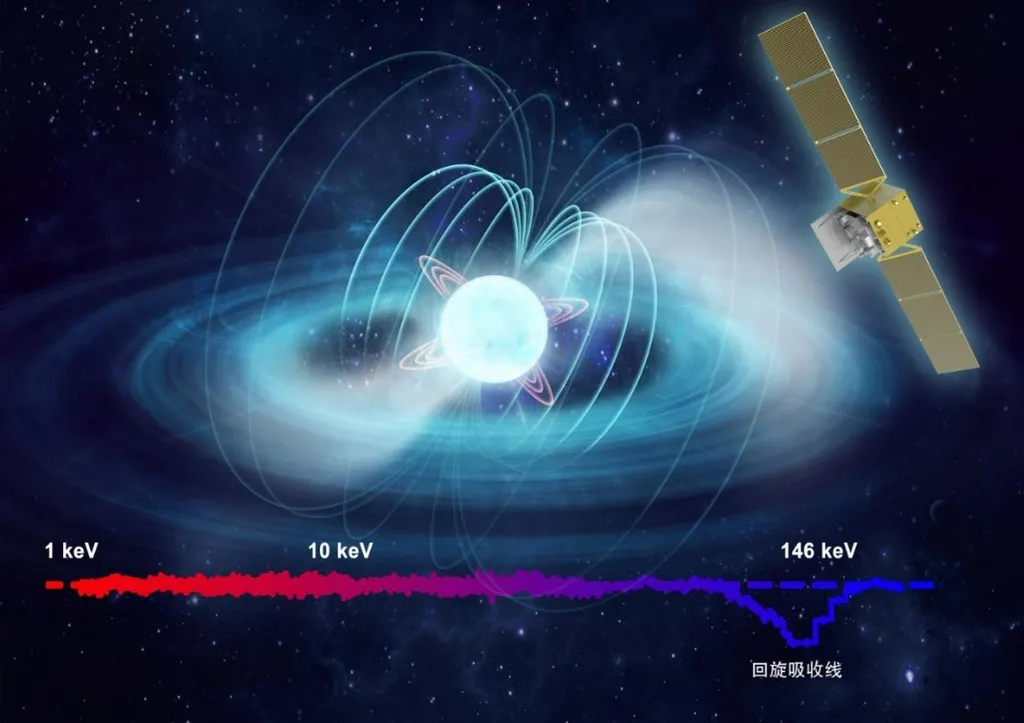Découverte par Insight-HXMT de la ligne d’absorption fondamentale du cyclotron électronique près de 146 keV pour le premier pulsar galactique ultralumineux à rayons X Swift J 0243.6+6124. Crédit : Image de l’IHEP
Insight-HXMT bat son propre record de mesure du champ magnétique le plus puissant de l’Univers
Les étoiles à neutrons génèrent les champs magnétiques les plus puissants de l’univers. Cependant, le seul moyen dont nous disposons pour mesurer directement leur champ magnétique de surface est d’observer les raies d’absorption cyclotron dans leur spectre d’énergie X. Récemment, l’équipe Insight-HXMT a découvert une ligne d’absorption cyclotronique d’une énergie de 146 keV dans l’étoile à neutrons binaire à rayons X Swift J0243.6+6124, ce qui correspond à un champ magnétique de surface de plus de 1,6 milliard de Tesla.
Après la mesure directe du champ magnétique le plus puissant de l’univers à environ 1 milliard de Tesla en 2020, les records mondiaux de la ligne d’absorption cyclotronique de la plus haute énergie et de la mesure directe du champ magnétique le plus puissant de l’univers ont été largement battus.
Les résultats, qui ont été publiés le 28 juin 2022 dans la revue Astrophysical Journal Letters (ApJL), ont été obtenues conjointement par le Laboratoire clé d’astrophysique des particules de l’Institut de physique des hautes énergies (IHEP) de l’Académie chinoise des sciences et l’Institut d’astronomie et d’astrophysique, Centre Kepler pour l’astrophysique et la physique des particules, Université de Tübingen (IAAT). Le Dr Lingda Kong, le professeur Shu Zhang et le professeur Shuangnan Zhang de l’IHEP sont les auteurs correspondants de l’article. Le Dr Victor Doroshenko et le professeur Andrea Santangelo de l’Université de Tübingen ont contribué de manière significative à la découverte.
Une neutron star X-ray binary system consists of a neutron star and its companion star. Under the strong gravitational force of the neutron star, the gas of the companion star falls towards the neutron star, forming an accretion disk. The plasma in the accretion disk will fall along magnetic lines to the neutron star’s surface, where powerful X-ray radiation is released. Along with the rotation of the neutron star, such emissions result in periodic X-ray pulse signals, hence the name “X-ray accretion pulsar” for these objects.
Many observations have revealed that these types of objects have absorption structures in their X-ray radiation spectra, namely cyclotron absorption lines, which are thought to be caused by resonant scattering and thus absorption of X-rays by electrons moving along the strong magnetic fields. The energy of the absorption structure corresponds to the strength of the surface magnetic field of a neutron star; therefore, this phenomenon can be used to directly measure the strength of the magnetic field near the surface of the neutron star.
Insight-HXMT’s discovery of the fundamental electron cyclotron absorption line near 146 keV for the first Galactic ultraluminous X-ray pulsar Swift J 0243.6+6124. Credit: Image by IHEP
Ultraluminous X-ray pulsars are a class of objects whose X-ray luminosity far exceeds that of canonical X-ray accreting pulsars. They have previously been discovered in several galaxies far from the Milky Way. Astronomers have speculated that their pulsars have high magnetic field strengths even though direct measurement evidence is still lacking.
Insight-HXMT made detailed and broadband observations of the outburst of Swift J0243.6+6124, the Milky Way’s first ultraluminous X-ray pulsar, and unambiguously discovered its cyclotron absorption line. This line revealed energy up to 146 keV (with detection significance of about 10 times the standard deviation), which corresponds to a surface magnetic field of more than 1.6 billion Tesla. This is not only the strongest magnetic field directly measured in the universe to date but also the first detection of an electron cyclotron absorption line in an ultraluminous X-ray source, thus providing direct measurement of the neutron star’s surface magnetic field.
It is believed that the surface magnetic fields of neutron stars have complex structures, ranging from dipole fields very far from the neutron star to multipole fields only influencing the area close to the neutron star. However, most earlier indirect estimates of the magnetic fields of neutron stars have probed only the dipole fields.
This time, the direct magnetic field measurement by Insight-HXMT based on the cyclotron absorption line is about an order of magnitude greater than that estimated using indirect means. This serves as the first concrete evidence that a neutron star’s magnetic field structure is more complex than that of a traditional symmetric dipole field, and it also provides the first measurement of the nonsymmetric component of a neutron star’s magnetic field.
Reference: “Insight-HXMT Discovery of the Highest-energy CRSF from the First Galactic Ultraluminous X-Ray Pulsar Swift J0243.6+6124” by Ling-Da Kong, Shu Zhang, Shuang-Nan Zhang, Long Ji, Victor Doroshenko, Andrea Santangelo, Yu-Peng Chen, Fang-Jun Lu, Ming-Yu Ge, Peng-Ju Wang, Lian Tao, Jin-Lu Qu, Ti-Pei Li, Cong-Zhan Liu, Jin-Yuan Liao, Zhi Chang, Jing-Qiang Peng and Qing-Cang Shui, 28 June 2022, Astrophysical Journal Letters.
DOI: 10.3847/2041-8213/ac7711
The Hard X-ray Modulation Telescope (HXMT), also known as Insight, is a Chinese X-ray observatory launched on June 15, 2017 aboard a Long March 4B rocket from the Jiuquan Satellite Launch Center. The mission provides high resolution imagery across a wide spectrum of X-ray energies.
Insight-HXMT is the first Chinese X-ray astronomy satellite. It comprises scientific payloads including a high-energy telescope, medium-energy telescope, low-energy telescope, and a space environment monitor. Insight-HXMT has advantages over other X-ray satellites in terms of broadband (1-250 keV) spectral coverage, large effective area at high energies, high time resolution, low dead-time, and no pile-up effects for bright sources, thus opening up a new window for observing black holes, neutron stars with hard X-ray fast transitions, and energy spectrum studies.
In 2020, the Insight-HXMT team reported the detection of a 90 keV cyclotron absorption line from a neutron star in the X-ray binary system GRO J1008-57, corresponding to a surface magnetic field of 1 billion Tesla, which set a world record for direct measurement of the universe’s strongest magnetic field at the time. Later, a new record for a cyclotron absorption line—with its highest energy around 100 keV—was detected by Insight-HXMT from another neutron star in 1A 0535+262. Insight-HXMT has demonstrated its exceptional capacity to explore the energy spectrum by breaking its own records for cyclotron absorption line discoveries.
Insight-HXMT was proposed by Professor Tipei Li and Professor Mei wu in 1993 at IHEP and was successfully launched on June 15, 2017. Its development is supported by the China National Space Administration and CAS. IHEP was responsible for satellite payloads, ground segments, and scientific research for this mission. The China Academy of Space Technology was responsible for the satellite system. Tsinghua University participated in the development of payload and ground segments. The National Space Science Center and Beijing Normal University were also involved in the mission. The calibration of the detectors on board Insight-HXMT was supported by the National Institute of Metrology, Ferrara University in Italy, and the Max Planck Institute for Extraterrestrial Physics.




